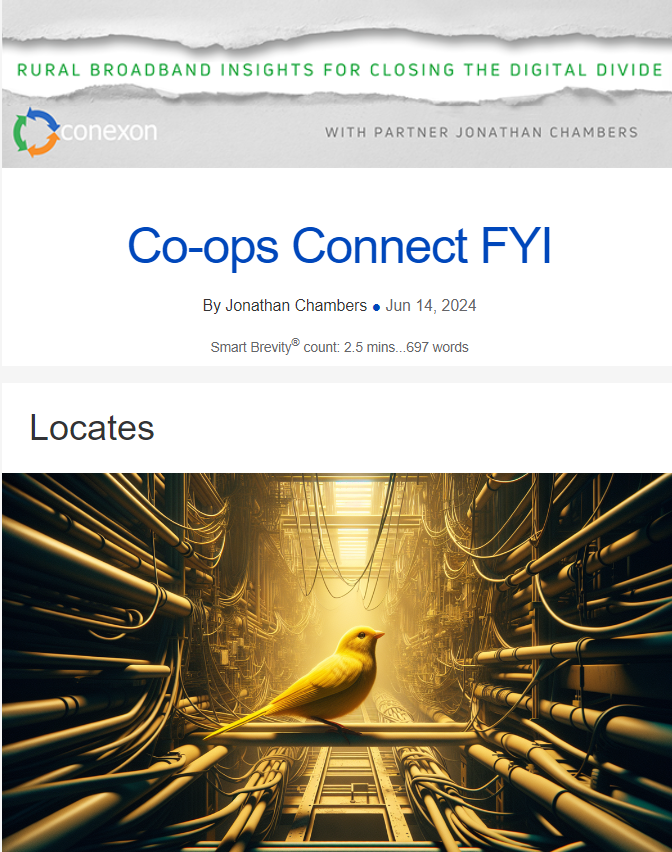Locates
June 14, 2024
I have written about the importance of a BEAD-funded pole replacement program for fiber construction in rural unserved and underserved areas. I proposed this type of program to jump-start the languishing BEAD program.
There is an equally important reason to initiate a pole replacement program as part of BEAD:
State broadband offices should expect delays in underground construction — specifically, delays in locates.
“Locates” refers to the locating and marking of existing underground facilities: pipes, sewers, conduits, cables, valves, lines, wires, manholes, attachments, and parts of poles or anchors, both above or below ground.
- Normally, companies performing “locates” services have contracts with the owners of these facilities, whether they be gas, power, water, sewage, or anything else run underground.
- Normally, the company performing the locating services charges the facilities owners.
- But these are not normal times.
What’s changed:
Increased building of rural fiber networks has led to certain supply chain bottlenecks over the past few years.
At Conexon, we strive to manage our supply chain to prevent delays in construction.
- In anticipation of the RDOF auction, for example, we secured an annual supply of 40,000-50,000 miles of fiber cable.
- With the assistance of our partners, we established a training facility for splicers.
- We also initiated our own make-ready engineering capability.
- The bottom line: We regularly scan for areas where a surge of activity might lead to shortages, with our volume of rural construction giving us canary-in-the-coal-mine-like foresight.
Which is why I’m writing this week about locates.
A Timeline of the Problem

A couple of years ago, I reached an agreement with a county council to build to all unserved locations in the county in exchange for ARPA funds. The ARPA program requires funds be used within a specific period, and at our normal pace of construction, the timeframe presented no obstacles.
In total, this fiber project is 5,000-6,000 miles. As with most of our construction, 90% of this project’s miles will be built on electric co-op poles.
However:
In this one county, there are about 100 miles of underground construction. Last fall, we began requesting locates for this underground construction. Most regulations require locates be completed in 48-72 hours, which has been consistent with our experience.
To date, little progress has been made on locates for our 5,000-6,000-mile project.
- At the locates company’s pace, it will take four years to complete the 100 miles. They simply don’t have the manpower in that geographic area.
- But (and there’s always a but) for $500,000, they will bring additional personnel from other areas and complete the work in six months.
- That’s in addition to — not in lieu of — what they charge to their own clients, i.e., the electric, water, gas, and telecom companies that employ them.
Locates is a problem now – before the pending onrush of public funding and construction activity that will be occasioned by BEAD.
Worse still, there are states whose NTIA-approved BEAD plans are unwisely favoring underground construction.
- I say unwisely because underground construction, when poles are available, is several times more expensive.
- And, the pace of underground construction is several times slower.
- And, underground construction is typically more disruptive than overhead construction.
A Glimpse of the Future

The problem is about to get worse.
After more than three years of funding delays, NTIA and the state broadband offices are going to try to spend over $40 billion in a concentrated period of time on rural broadband construction.
It doesn’t take a fancy degree to deduce that locates will become a bottleneck.
- Currently, locates companies are not training sufficient personnel.
- As a result, they will move personnel around to the highest bidders.
- If states and NTIA choose to favor underground construction, the bottleneck will become a blockade.
- After years of funding delays, there will be construction delays.
The big picture:
All the more reason for NTIA and the states to establish pole replacement programs now. [See last week’s Co-ops Connect FYI]
Otherwise, that silence you hear is the absence of construction.
The canary has stopped singing.
